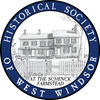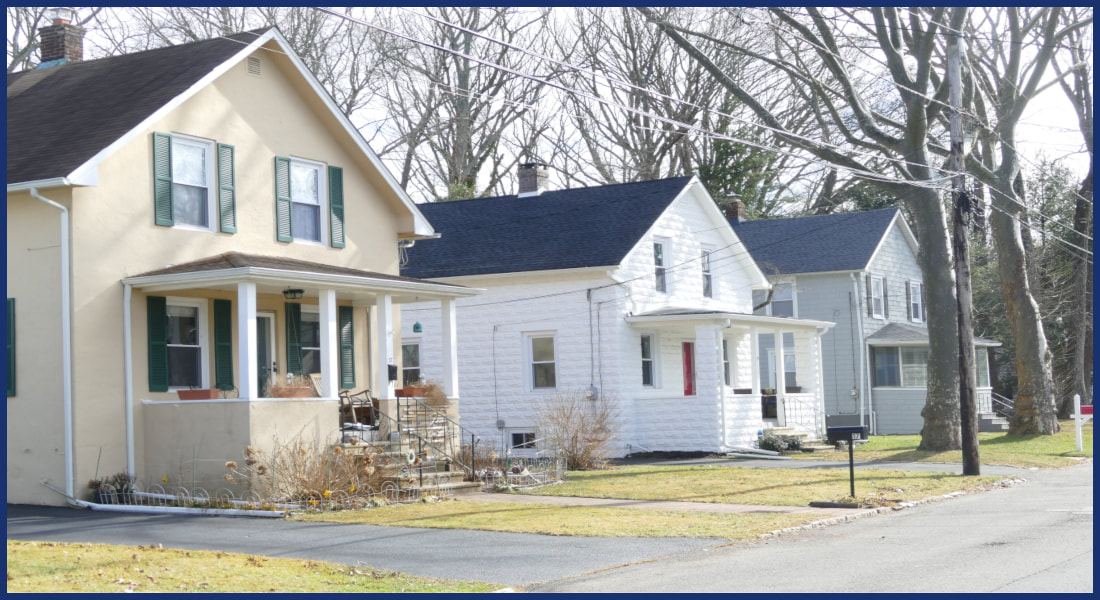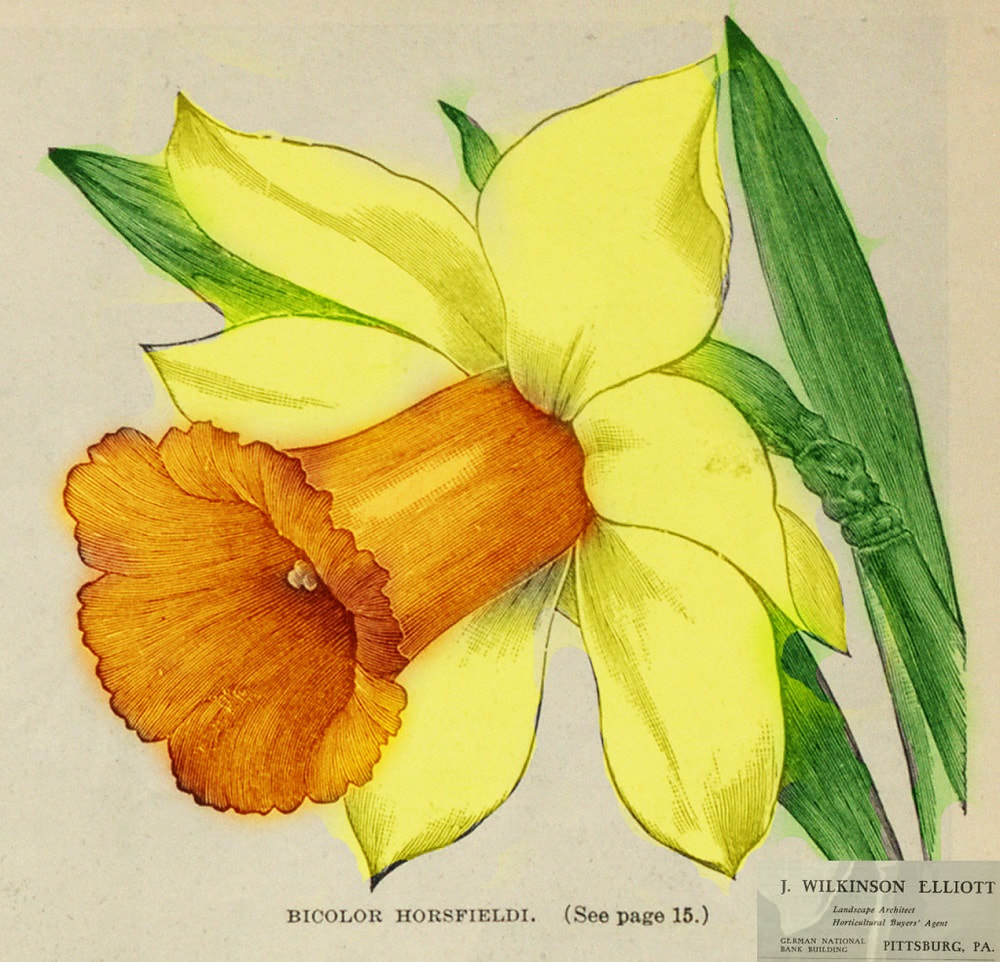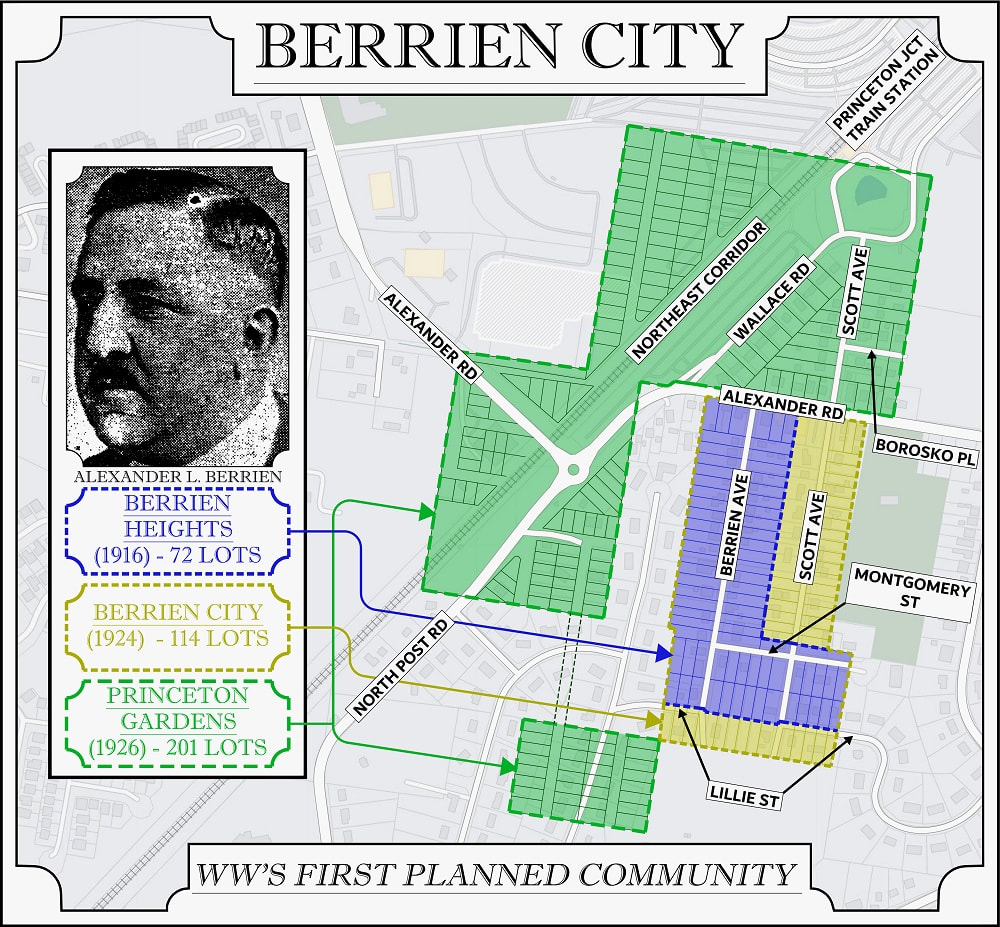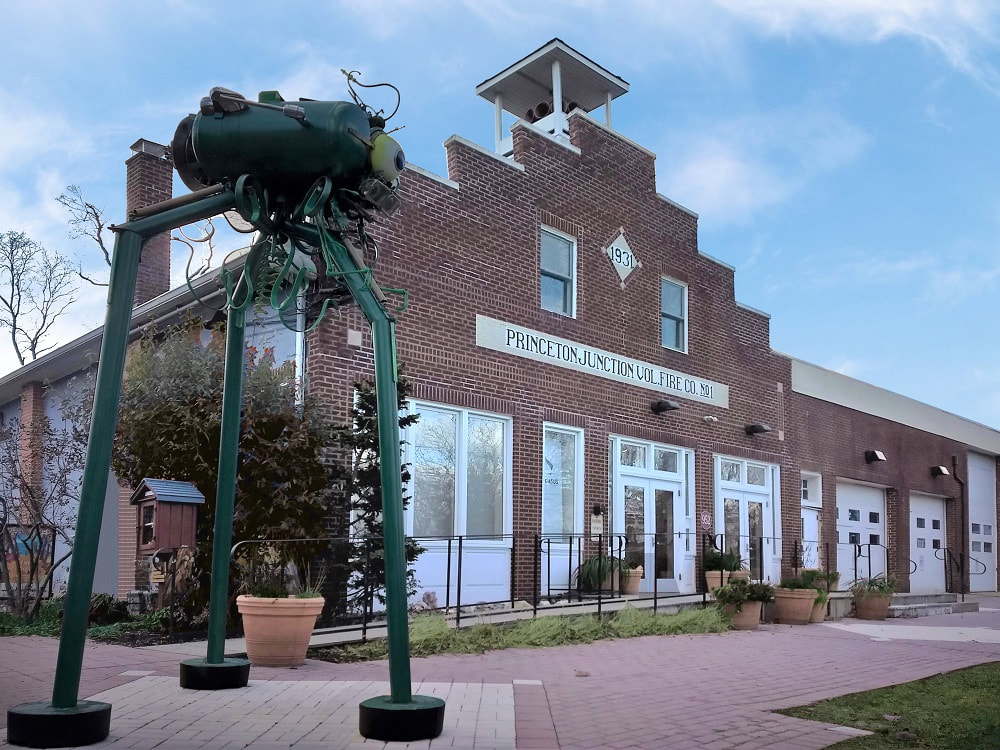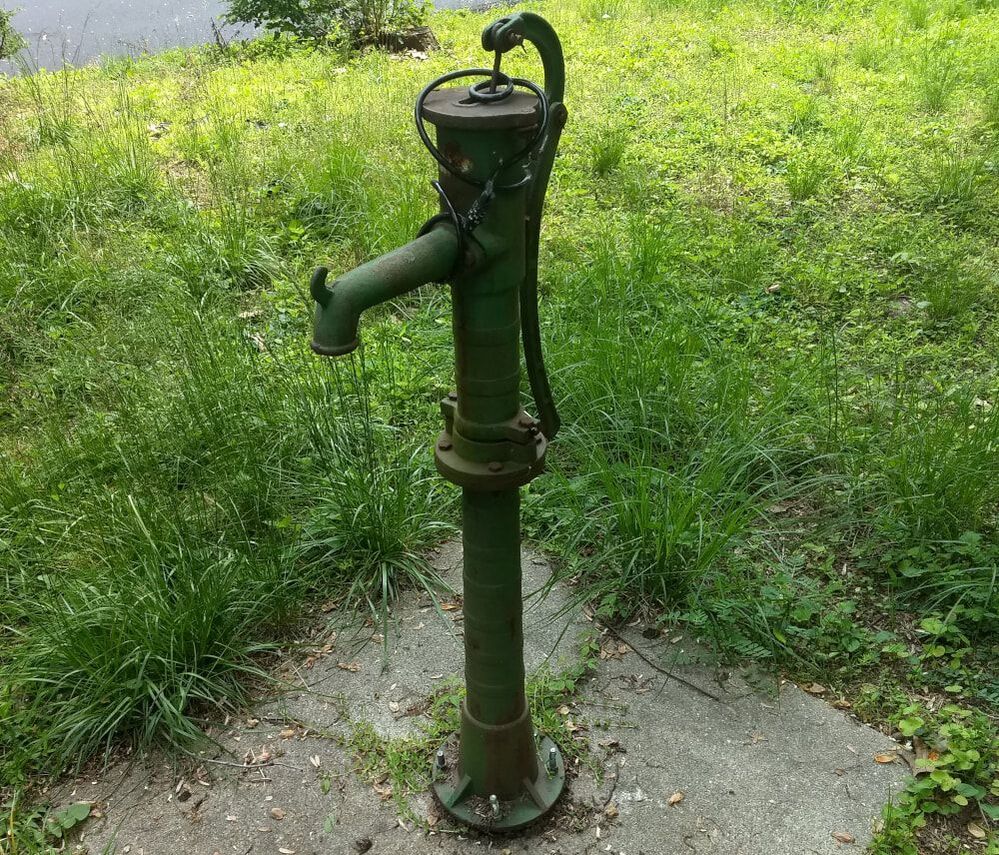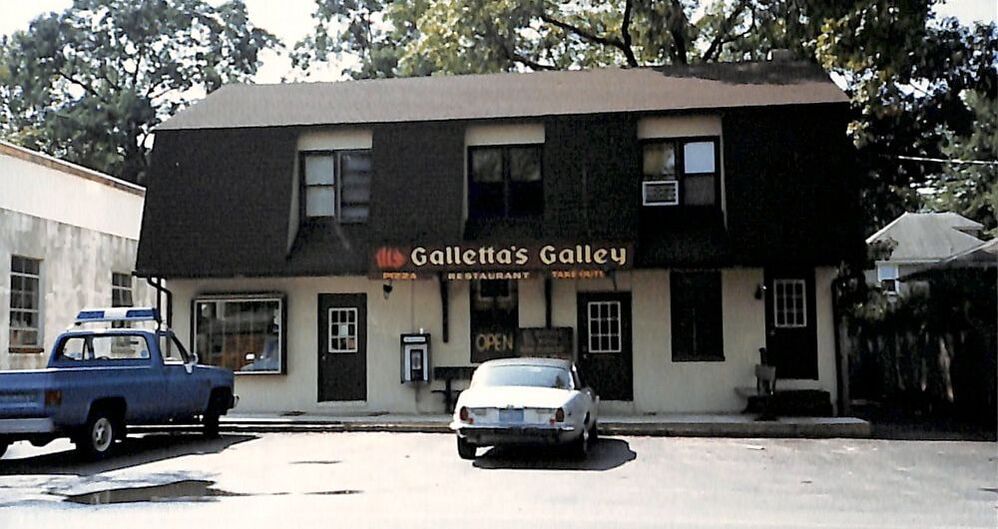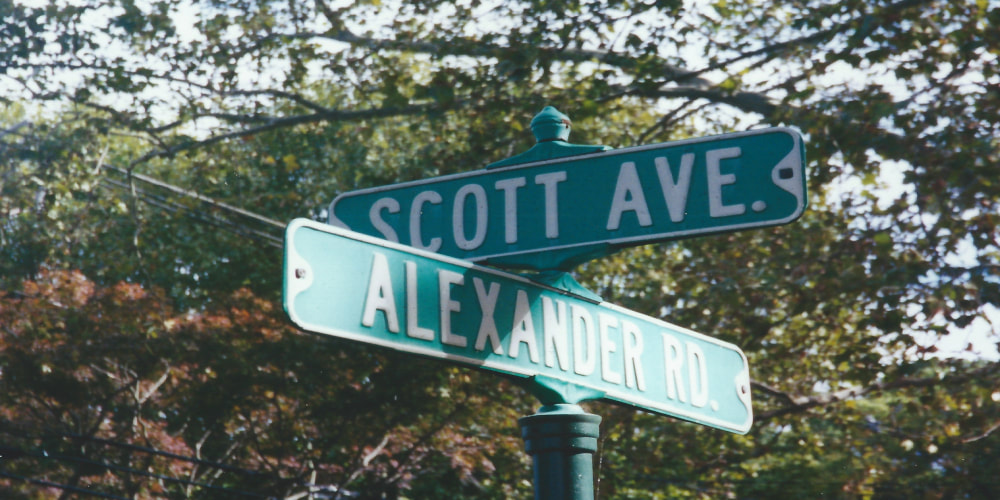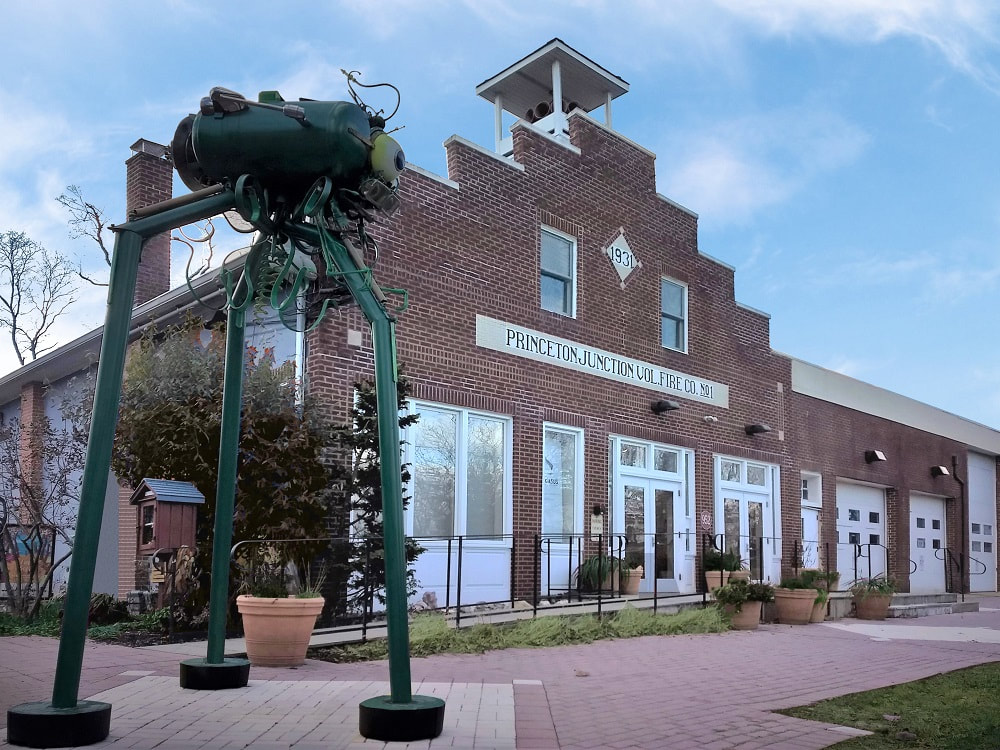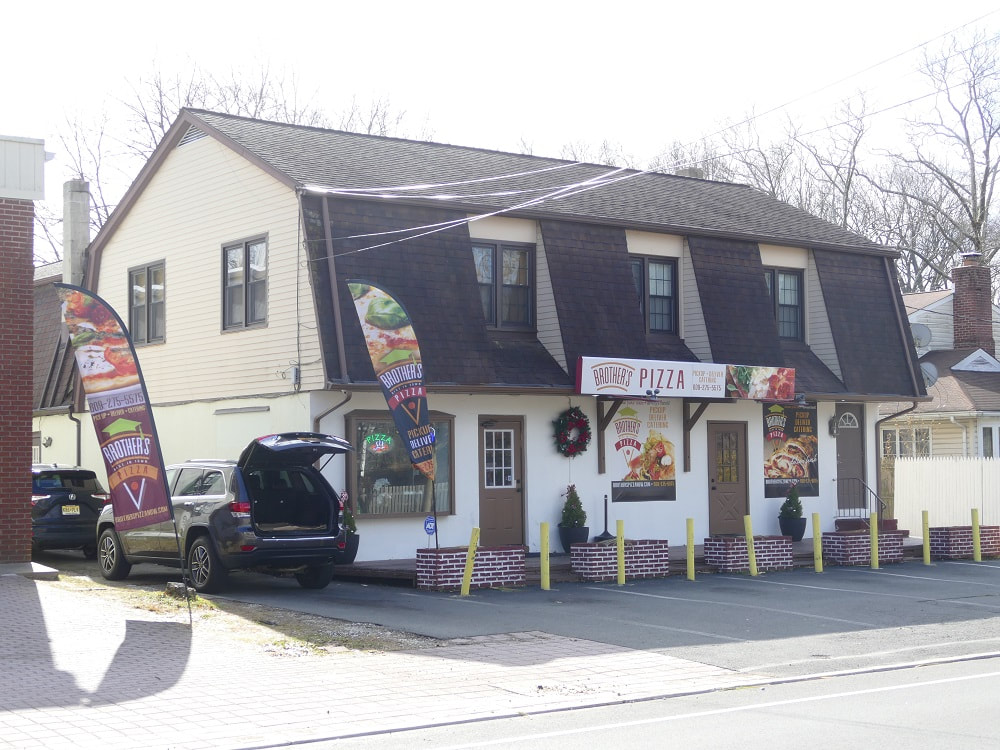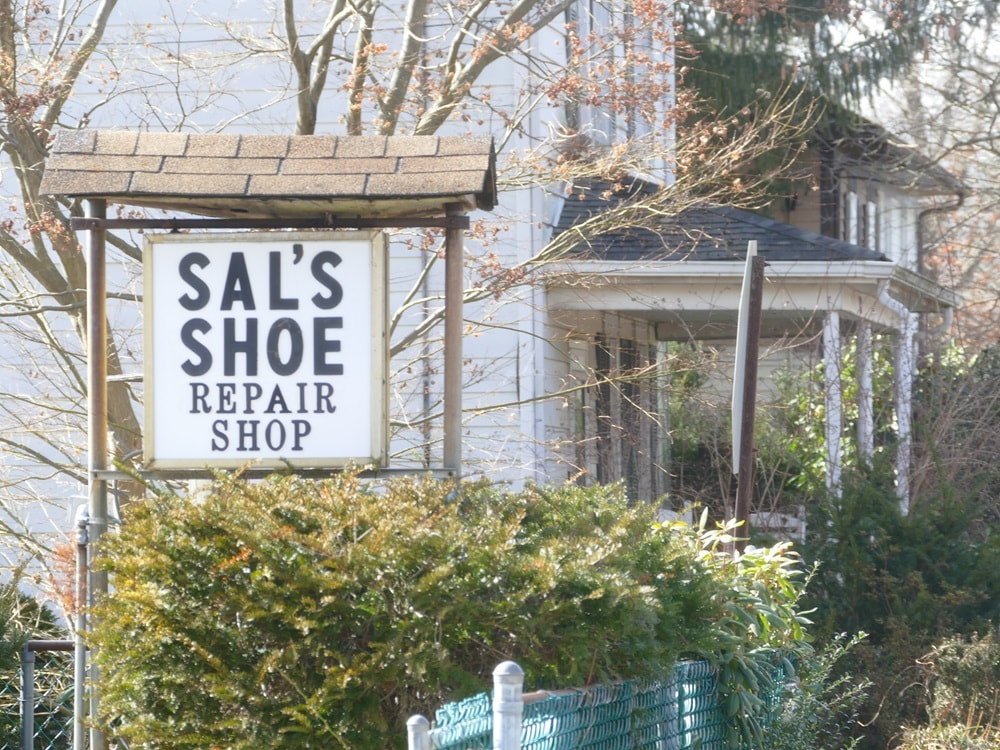Berrien City
Just south of the Princeton Junction Train Station is a residential neighborhood called "Berrien City." This charming district surrounds Alexander Road, Berrien and Scott Avenues, and Emil, Montgomery, Borosko, and Lillie Streets. It is part of the broader historic community of Princeton Junction and arose as West Windsor's first planned development in the 1910s. Many dozens of old houses, picturesque tree-lined streets, and a fire station-turned-arts center help define the neighborhood's identity. Explore Berrien City and its historical buildings below!
Historical Overview
|
Before Berrien City, much of the land south of the train station was owned by a company called “Elliott Nurseries.”[1] In 1889, a man named James Wilkinson Elliott, established this plant nursery firm in Pittsburgh. Because of his relationships with the celebrities of his times, and his savvy marketing skills, his company gained country-wide recognition. He was even close friends with James Walter Thompson, one of the most influential advertisers in American history.[2]
Because Elliott Nurseries’ products were in such demand, they branched out to locations outside of Pittsburgh. From 1912 to around 1919, Elliot Nurseries owned a distribution center in Princeton Junction, straddling either side of the railroad tracks. They sold trees and shrubs at what they called “sacrifice prices.” [3],[4] By 1919, Elliott Nurseries began to close up shop in Princeton Junction, due to lingering complications from World War I.[5] However, there may be remnants of Elliott nurseries left in Berrien City - especially several of the very oldest trees, which grow close to some of the roads. Today, trees are an integral part of the neighborhood. Arboreal canopies in the spring, summer, and fall add a sense of place to nearly every part of Berrien City. |
|
Despite its singular name, “Berrien City,” was actually historically three communities that are now collectively known as "Berrien City." In chronological order, they are Berrien Heights, Berrien City, and Princeton Gardens.
The idea for West Windsor’s first planned development originated with a man named Scott Berrien. In 1916, Scott presented plans to the Town Committee for a development he called “Berrien Heights.”[6] It featured 72 properties with uniform lots, surrounding two new roads: Berrien Avenue and Montgomery Street.[7] About sixteen homes (still standing in 2023) perhaps date to the time of Berrien Heights, and about half a dozen may predate the development.[8] Scott died in 1922,[9] but by 1924, his son, Alexander, had purchased enough property to expand Berrien Heights from 72 to 114 lots, renaming it “Berrien City.” Like his father, he sold only the land itself to buyers, who built their own houses. Berrien City included three new roads - Lillie Street, Scott Avenue, and Emil Street – named after his sister, father, and brother-in-law, respectively.[10] Alexander died in 1926.[11] His son, Alexander Jr., possibly lived in Berrien City. He, and the Princeton Bank & Trust Company, carried on his father’s business for several years.[12] |
|
Also in 1926, a real estate developer named Michael McLaughlin proposed a third community, called “Princeton Gardens.” The original plans featured 201 lots on both side of the railroad. However, only part of the community – all east of the tracks - was actually developed, around the newly-constructed Wallace Road and the northern extension of Scott Avenue, as well as Emil Street and the railroad bridge.[13] Borosko place was also constructed, and unlike the other streets, was actually named after a local family of Hungarian immigrants.[14]
In 1926, the Berrien City Fire Company - now the Princeton Junction Volunteer Fire Company - formed as a supplement to the West Windsor Volunteer Fire Company,[15] which had been established in the community of Dutch Neck five years prior.[16] In 1930, they bought land fronting Alexander Road from the Holmes and Walker families, erecting a firehouse there in 1931.[17],[18] Over the decades, the building was enlarged and served as a community center of sorts.[19] In 2010, this became the West Windsor Arts Center - headquarters of the West Windsor Arts Council.[20] |
|
Berrien City itself also grew significantly in the 1900s as dozens of new families built dozens of new homes. Many of the brick houses were constructed by Charles Aversano, and many of the stucco houses were built by the Hall family. Locals talk of finding leftover materials from the Pennsylvania Railroad in their homes. Several houses were built from modular kits purchased from Sears, Roebuck, Weyerhauser, and other companies. Family, friends, and neighbors occasionally helped with construction.[21]
Berrien City also had its own water company. Around the intersection of Scott Avenue and Wallace Road, there was a fresh water spring. Residents filled jugs there for drinking, until it was capped in the 1970s. Another water tower, with an electric pump, was located at the corner of Scott Avenue and Montgomery Streets at least as far back as the 1940s, if not earlier. During the winter, the tower often overflowed, forming ice sculptures. In 1968, the Princeton Junction Water Company was sold to the Elizabethtown Water company, which installed water mains.[22] |
|
Berrien City’s sense of community has been evident throughout its existence. During the Great Depression, Bingo games at the firehouse were popular.[23] During World War II, the building also served as a Civil Defense station.[24],[25] In the 1940s, the local post office moved very briefly to the firehouse, then to the building now (2023) occupied by Brother’s Pizza.[26] In the 1970s and 1980s, this same building housed an Italian restaurant called “Galletta’s Galley,” and before that “Howard’s Luncheonette.”[27] Sal’s Shoe Repair Shop next door, is another longtime staple (founded in 1977 by Salvatore Balestrieri, an Italian immigrant). Other local efforts - including the Berrien City Neighborhood Association - have also helped define the community’s identity.[28]
|
|
Until recently, Berrien City was also home to one of West Windsor’s most famous residents – John Forbes Nash, Nash was a mathematical genius who he earned his PhD in 1950 with a dissertation on non-cooperative games. He also made contributions to singularity theory, geometry, and much more, and even predicted many contemporary cryptographic concepts.[29]
Nash is also well known for his decades-long struggles with schizophrenia. These struggles, and Nash’s eventual recovery after many long years, were the subject of Sylvia Nasar’s 1998 book “A Beautiful Mind” and the film of the same name.[30] In 1994, Nash received the Nobel Prize in Economic Sciences based on his contributions to game theory. The next year, he became a Senior Research Mathematician at Princeton University. He won myriad other distinctions over the years.[31] From around the 1970s onward, Nash and his family lived in Berrien City. He took the Dinky Line to work in Princeton and was a familiar local face.[32] Nash Park nearby on Alexander Road is named after him. Sadly, he and his wife, Alicia, passed away in a car crash in 2015 shortly after he received the highest award for mathematics in the world - the Abel prize.[33] However, their legacies, and Nash’s immense contributions to the world, persist. |
|
Today, Berrien City, while part of West Windsor, retains a unique identity and sense of place. Its tree-lined avenues evoke a time when the surrounding land was nothing but farm and nursery. Its architectural diversity sets it apart from many other West Windsor developments. Its proximity to the train station is a constant reminder of Princeton Junction’s 1800s-era roots. And most importantly, its clear sense of “place” and “community” makes its history well worth preserving and celebrating.
|
Historical Berrien City Landmarks
Click on each of the images below to explore some Berrien City landmarks! We recommend reading them in order. More sites may be added as research improves.
Bibliography
- Sincerbeaux, C. S. “Map Showing Plan of Lots for Scott Berrien Esq.” Map. West Windsor, New Jersey, 1916.
- “Research Guides: Nursery and Seed Catalogs: Elliott Nursery Company.” Elliott Nursery Company - Nursery and Seed Catalogs - Research Guides at New York Botanical Garden. Accessed September 20, 2023. https://libguides.nybg.org/c.php?g=655017&p=4597872.
- "Many Fine Estates Grace Princeton." Trenton Evening Times. August 9, 1912.
- Elliott Nursery Company. (1919, March). Trees and Shrubs at Sacrifice Prices. Country Life Magazine.
- Ibid.
- Sincerbeaux, C. S. “Map Showing Plan of Lots for Scott Berrien Esq.” Map. West Windsor, New Jersey, 1916.
- Ibid.
- "West Windsor Tax Assessor Address List, 2019.” West Windsor, 2019. List of all residences in West Windsor with dates of construction, according to tax assessor. Sent to the Historical Society by Lorraine Jones and Dawn Moretti.
- "Scott Berrien is Called By Death." Trenton Evening Times. November 22, 1922.
- Sincerbeaux, C S. “Map Showing Plan of Lots for Alexander L. Berrien, Esq. - Berrien
City.” West Windsor, New Jersey, 1924. - "Mr. Alexander L. Berrien Dies After Long Illness." Princeton Herald. May 21, 1926.
- "Heir to Carry Out Berrien City Project." Trenton Evening Times. June 4, 1926.
- “Map Showing Plan of Lots for Michael McLaughlin, Esq. - Princeton Gardens.” Map. West Windsor, New Jersey: Sincerbeaux & Moore, 1926.
- United States Census, 1920 - West Windsor Township.” West Windsor Township, 1920.
- Trenton Evening Times, August 21, 1926. Untitled article mentions the “Newly organized Berrien City Fire Department.”
- "Minutes and Records of the West Windsor Township Volunteer Fire Company, Organized March 21, 1921.” West Windsor: West Windsor Volunteer Fire Company No. 1 firehouse, n.d. Minutes detailing the first 11 years (1921-1932) of the West Windsor Volunteer Fire Co. No. 1’s development.
- Holmes, Levi C., Holmes, Sarah E., Princeton Junction Volunteer Fire Company. “Indenture.” West Windsor, 1930. Located in the Mercer County Clerk's Office, Mercer County Deed Book 466 Page 581.
- Walker, Elizabeth, Walker, John Thomas, Princeton Junction Volunteer Fire Company. “Indenture.” West Windsor, 1930. Located in the Mercer County Clerk's Office, Mercer County Deed Book 385 Page 540.
- Tindall, Wayne, Mary Schenck, William Manuel, Lorraine Kapp, and James Yates. “Broadside,” 1995. Broadside article covering the history of both of West Windsor’s fire companies (Part 1).
- “About: West Windsor Arts.” West Windsor Arts Center. West Windsor Arts Council, March 22, 2023. https://westwindsorarts.org/about/. Includes a history of the West Windsor Arts Council and West Windsor Arts Center.
- Flickinger, Jeanette R., Eleanor Dearborn, George Krebs, and Francis Ward. “Broadside,” Fall 1992. Broadside article covering the history of Berrien City and Glen Acres.
- Ibid.
- Tindall, Wayne, Mary Schenck, William Manuel, Lorraine Kapp, and James Yates. “Broadside,” 1995. Broadside article covering the history of both of West Windsor’s fire companies (Part 1).
- Ibid.
- “West Windsor Township Defense Council, Correspondence and Records, 1941 - 1945 (MWFDE001).” Trenton, February 22, 2022.
- "Weekend Move by Post Office a Surprise." July 29, 1970. Trenton Evening Times.
- Castaldo, P. (2018, June 3). So Why Galletta’s Galley? Galletta’s Galley. https://gallettasgalley.com/2018/04/so-why-gallettas-galley/
- Anon. “Berrien City News,” August/September 2003. Newsletter produced by the Berrien City Neighborhood Association (BNCA).
- “The Sveriges Riksbank Prize in Economic Sciences in Memory of Alfred Nobel 1994.” NobelPrize.org. Accessed September 20, 2023. https://www.nobelprize.org/prizes/economic-sciences/1994/nash/biographical/.
- Ibid.
- Ibid.
- "Two years after parents' death, son of 'A Beautiful Mind' John Nash' has one regret." NJ.com. June 11, 2017.
- Ibid.
